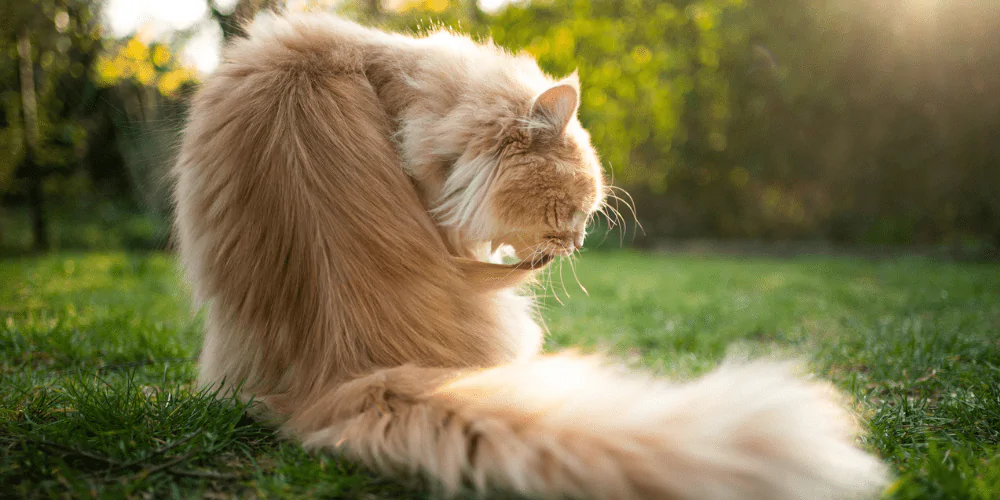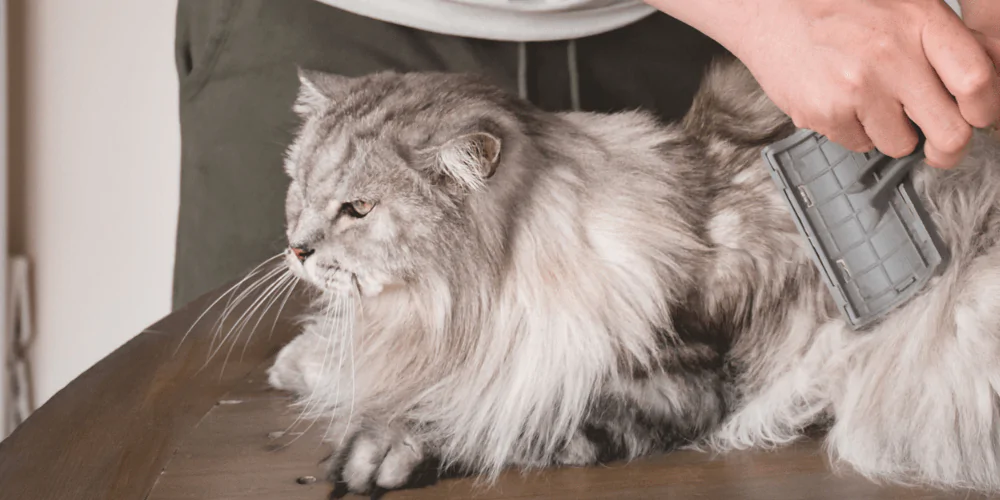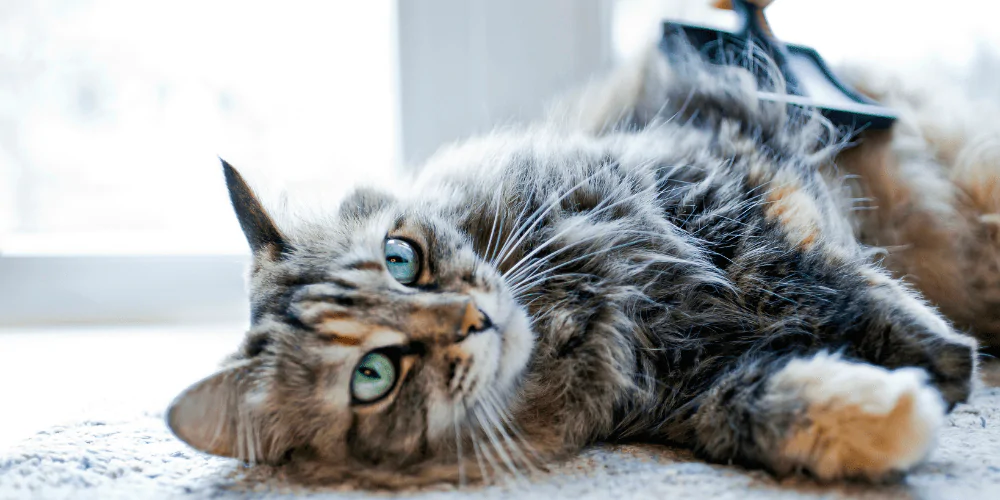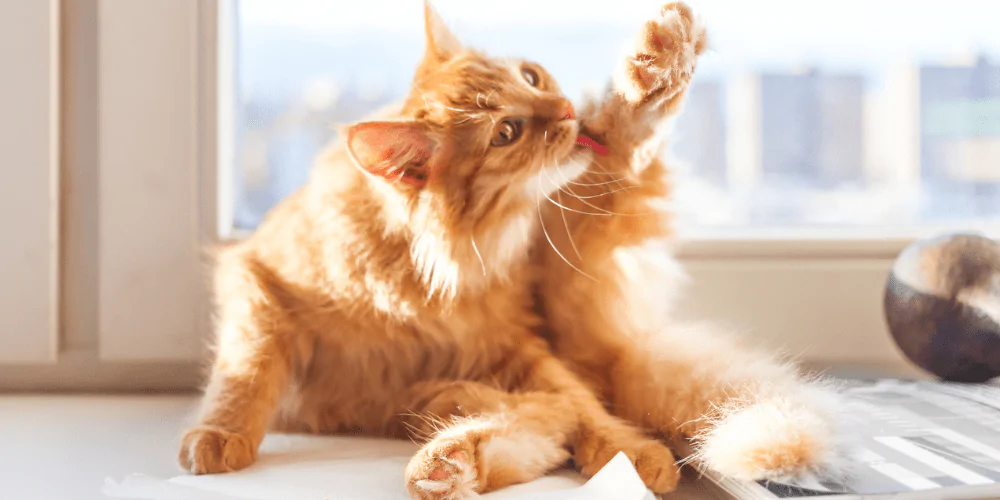
Your handy guide to grooming a long-haired cat

Dr Corinne Wigfall BVMBVS(Hons) BVMedSci(Hons)
29 January 2024 | 5 minutes read
Your favourite feline’s long, luscious mane is a thing of beauty – but it doesn’t look after itself!
Keeping your cat’s coat in tip-top condition is important for their health and well-being. So read on to find out how to groom your long-haired cat from expert vet Dr Corinne.
- Do long haired cats need to be groomed?
> Does grooming a cat help with shedding? - How to groom a long haired cat
> How to groom a cat that hates it - How to stop your cat from over-grooming

Do long-haired cats need to be groomed?
Grooming plays a big part in the overall health and well-being of every cat. Brushing your cat’s fur:
- Removes loose hair, dead hair, and dead skin
- Keeps your cat’s coat free of dirt and grime
- Clears away other unwanted things like parasites
- Spreads your cat’s natural oils across their coat to help keep their skin healthy
- Helps you keep a close eye on their general coat condition and body shape
- Reduces the frequency of hairballs
Long-haired cats need even more TLC as they struggle to keep up with all that grooming of themselves. You’ll need to brush them at least two to three times a week to help maintain that fabulous fur.
Without regular brushing, your feline’s fur can become matted and uncomfortable. This is especially true of those warmer months when matted fur can trap warm air on your cat’s skin. Matted fur is painful and creates sores by pulling on the skin underneath.
> Does grooming a cat help with shedding?
Regularly grooming your cat to remove loose hairs can help to reduce shedding around the house.
But there are also other reasons why your cat might have lots of shedding:
- A poor quality or unbalanced diet
- A skin infection or allergy
- Being pregnant
- A hormonal imbalance
- High levels of stress

How to groom a long-haired cat
With a bit of patience and the right tools, you can give your feline’s majestic mane a successful grooming session at home.
Step 1 – Gather your grooming tools
You’ll need to gather:
- A slicker brush to detangle and smooth the fur
- A comb to tease out knots
- A pair of cat-safe scissors to do any trimming as needed
Step 2 – Make things calm for your cat
Your cat can pick up on stress, so make sure everything is calm and relaxed before you begin.
- Head to a quiet area of the house where there are no loud, sudden noises and your cat will be comfortable.
- Choose a time when they’re feeling more chilled out, like after a meal or playtime.
Step 3 – Start slowly and gently
- Begin by showing your cat the slicker brush and let them rub their scent on it to make the brush smell more familiar.
- Using a light touch, start at the top of your cat’s head and brush gently for a few seconds in the direction their hair grows.
- Keep using lots of gentle praise and reward your cat each time you brush them. You can also add in some small treats when first starting to help your cat like this activity.
- Move on to the next area of their body, always checking in with your feline to make sure they’re comfortable.
It’s important to brush in the direction of hair growth and take extra care around sensitive areas like the belly and chest.
Step 4 – Tackle matting with care
- Use the comb to gently tease apart any mats in your cat’s fur. Hold the fur between your fingers to reduce pressure on the roots of the hair as this can be painful.
- Carefully use scissors to remove any large knots that won’t come out with teasing. Do not cut your cat’s hair unless you’re confident you won’t cause injury as cat skin is very fragile and bleeds easily.
A few extra things to note about grooming:
- Try to make a habit of brushing your cat daily, even if just for a few minutes. It’ll help to keep their coat smooth and prevent any knots or mats from forming.
- Remember to brush all of your cat’s body, not just their back. That means their chest, belly, and even their tail.

> How to groom a cat that hates it
A cat who shows distress when being brushed could be a sign that they’re in pain. Take them to the vet and they can check for any health issues.
Not all cats will take to being brushed straight away, and that’s OK.
- Start with short grooming sessions and gradually increase the time as your cat gets more comfortable.
- Keep the experience positive with plenty of gentle praise and reward.
- If your cat is still really struggling to let you brush their coat, think about taking them to a vet for a groom under light sedation. This can help with their anxiety.
Vets can prescribe anti-anxiety medication which may allow you to then groom your cat at home. So this can be something to look into if you’re struggling.

How to stop your cat from over-grooming
Over-grooming happens when your cat starts to excessively groom themselves. You might notice:
- Obsessive licking, biting, scratching or chewing
- Patches of shorter hair or baldness
- Redness
- Sores and scabs
Cats can overgroom anywhere on their body but the most common spots are the belly, legs, and thighs.
Over-grooming can be a common symptom of stress in cats. Always speak to your vet first to make sure no medical problems are causing the behaviour.
Once this has been ruled out, a qualified feline behaviourist can discover if there’s a social or environmental stress affecting your cat.
Protect your majestically-furred feline throughout their life with flexible cat insurance from Petsure.


